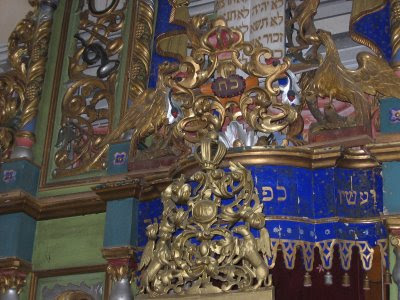, published June 1, was from Bielsko Biala, Poland and deals with the impact of perception, desire and demand on memory, particularly vis a vis the Jewish experience and Jewish heritage in Poland....
I'm posting the piece here, but will have more to say about B-B in a later post, with pictures from my trip.
Poland’s Jewish heritage is about more than just death
By Ruth Ellen Gruber · June 1, 2009
BIELSKO-BIALA, Poland (JTA) -- Outside the elegant theater in the city of Bielsko Biala in southern Poland, a billboard advertises an upcoming play. Stark letters spell out the title: "Zyd" -- Jew.
The lettering looks almost menacing, like scrawled graffiti, and I am a little taken aback.
But then I remember where I am.
This is Poland.
And the play, in fact, is an award-winning exploration of anti-Semitism and the power of stereotypes -- part of the endless continuing discussion here about the Jewish past, the Jewish present, and the long, complex and troubled relationship between Jews and Catholic Poles.
"There is no theme that Poles are more likely to discuss than Jews," the play's author, Artur Palyga told the Polish media. "It can be said that Judaism is our national passion."
"Zyd" deals with teachers in a provincial Polish town preparing for the visit of a former student, a Holocaust survivor who had attended their school before the Shoah, when Jews made up more than half the town's population.
Its portrayal of grassroots prejudice is graphic and sometimes grotesque. Indeed, the play came under fire in the right-wing press, and its premiere last year sparked protests.
Still, it won the main prize at a national festival of contemporary Polish drama for being "an honest, brave and theatrically precise attempt to settle accounts with the difficult Polish past."
The play is essentially about memory. In particular, it’s about the various uses to which memory is put, and how memory differs in the minds of different people considering the same past.
These issues have suffused much of my own work over the past two decades, as I have researched Jewish heritage sites in East and Central Europe and chronicled the Jewish experience in places were few or no Jews live today.
How are Jews and Jewish heritage remembered? Which Jewish places and personalities are incorporated into the local consciousness? How do local people choose to portray an important part of the population that was savagely removed, almost overnight?
I found Bielko Biala permeated with examples of how perspective influences memory.
They ranged from indifferent disregard to the kitschy commercialization of a "Jewish-style" restaurant called Rabbi, to an earnest attempt to acknowledge the contribution of Jews to the city.
Bielsko Biala was officially established in 1951 with the amalgamation of two towns on opposite sides of the Biala River, which for centuries formed the border between the Austrian Empire and Poland, and then the regions of Silesia and Galicia.
Before 1939, the population was divided among ethnic Germans, Jews and Poles, and the city remains a stronghold of Protestantism. The Nazis absorbed it into the Reich, and almost all the Jews were killed. After World War II, Poland took it over and expelled the ethnic Germans.
Only a small Jewish community lives here today, but Jews played a major role in local history. In the 19th century, Jewish industrialists helped build the city into a major textile center, and a local Jewish architect, Karol Korn, designed key buildings that still define Bielsko Biala.
Korn's grandest building -- the Moorish-style great synagogue -- no longer exists. Erected in 1881, it dominated the city's main avenue until it was blown up by the Nazis in 1939.
Today, a contemporary art gallery occupies the spot; a small plaque on an outer wall commemorates the destroyed building but says nothing about the community it once served.
There's a puppet theatre now next door, where the Jewish culture center once stood, and a courthouse occupies the former Jewish community building across the street. Its elaborate decoration, I was told, represents the seven fruits mentioned in the Torah.
The Jewish cemetery, whose red-and-orange striped ceremonial hall is another Korn design, is well maintained and designated a cultural monument. Among the tombs is a poignant memorial to Jewish soldiers who fell fighting for the Austrians in World War I.
All these sites, and more, are noted on Jewish heritage itineraries included in local guidebooks available at the tourist information office and the city museum. On sale in both places I found reproductions of old postcards portraying the synagogue in all its glory as a major pre-war landmark.
I have no way of knowing who follows these itineraries or purchases the postcards. But, at least for tourists, they clearly acknowledge the Jewish contribution to the town and set Jewish history and heritage here within the general matrix.
This marks a welcome contrast to the "Jewish heritage package" offered by one of the city's leading hotels.
Far from exploring the rich historic contribution of Jews here, its itinerary is simply a round trip to Auschwitz, with "sightseeing" at the memorial museum there, then dinner back at the hotel's restaurant.
Bielsko Biala is only 25 miles from Auschwitz. I would certainly urge anyone visiting the town to take a day and go there. But promoting a tour of the Nazis' most notorious death camp as a Jewish heritage package banalizes Jewish heritage and the Holocaust, and both ignores and insults the memory of the generations of Jews who lived here (and often prospered).
In Bielsko Biala, Poles have begun to offer up a more nuanced take on history -- Jewish and Polish. Unfortunately, however, hotel tourist packages tend to offer only what their clients demand. Jews should take the lead in demanding more.
Even in places where few or no Jews live anymore, Jewish heritage must not be equated with its destruction. Nor, indeed, should the centuries-old Jewish experience be defined solely in terms of death.















